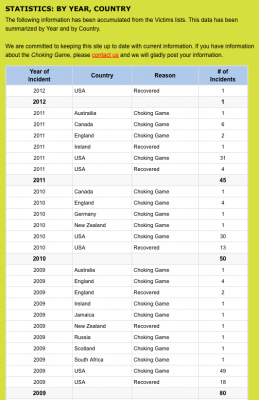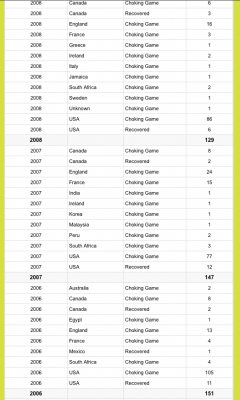Today, Yahoo had a link on their main page to an alarming Time story about an alarming trend — actually, it’s more like an epidemic! — of children (who are our future and our most precious resource) asphyxiating themselves in an effort to achieve a “high,” to just feel something in this callously dull world. This deadly dangerous activity goes by many names, but the most alarming by far is “The Choking Game,” and only the most naive among you don’t believe it’s already infected [1] your community.
Researchers at The Crime Victims’ Institute at Sam Houston State University surveyed 837 students at a Texas university and found that the behavior, which works by cutting off blood flow to the brain in order to induce a high, was frighteningly commonplace:
•16% of students said they’d played the game, and three-quarters more than once
•On average, students first played the game at age 14
•Males were more likely to have played than females
•90% of students who had played the game learned about it from friends, and most students said they first played in a group
16% of a group of 837 students at one Texas University might have choked or hyperventilated themselves at some point in the past. And three-quarters of those might have done it twice!
That is “frighteningly commonplace” (by the way, emphasis added, because, see below)! That’s practically everybody!
It turns out that The Choking Game is a crisis that media outlets have been trying to manufacture for some time. With limited success, because today was the first I’d ever heard of it — now, of course, I’m panicked. Anyway, back in 2010, Time also sounded an alarm [2]:
Known by various names around the world — including funky chicken, space monkey, sleeper hold and the blackout, choking or fainting game — the activity involves applying pressure to the neck to stop the blood flow to the brain and then releasing the pressure to create a temporary sense of euphoria. It isn’t new: French medical books mention the scarf game as early as the 18th century, and deaths in Britain, Canada and the U.S. have occasionally made the headlines over the years. What is new — and frightening — is that teenagers are now uploading instructional videos to the Internet that glamorize the potentially deadly practice.
Are you “frightened” by this “frighteningly commonplace” activity? People have been doing it since the 18th century for crying out loud! But, thanks to the murderous internet, that is literally killing [3] people [4] in Asian [5] countries, these misguided children have a new and frightening way of promoting their frightening activity.
But let’s get down to it. How many people are dying thanks to this frighteningly commonplace activity? As it turns out, “many.” Back to Time’s 2010 expose [2]:
Many teenagers already are dying. Figures on choking-game deaths remain sketchy — a lack of awareness among police means that cases often end up being classified as suicides. The Centers for Disease Control and Prevention in Atlanta estimates that at least 82 people died from the activity between 1995 and 2007. But according to the Wisconsin-based campaign group Games Adolescents Shouldn’t Play (GASP), as many as 1,000 young people die in the U.S. each year playing some variation of the game. In France, officials identified 17 deaths in 2009, but they suspect that many more go unreported.
Hold on a second — you mean that police have a “lack of awareness” of this frighteningly commonplace epidemic??? How could they be unaware of something that has killed 82 people between 1995 and 2007?
Oh, but wait, a special interest group formed to fight this frightening commonplace scourge claims that “as many as 1,000 young people die in the U.S. each year playing some variation on the game.” Are you frightened of that astonishingly equivocal statement?
Okay, let’s head over to the GASP website [6]. They’re the experts on this epidemic I’d never heard of before, despite all the frightening stories out there. What kind of statistics [7] do they have? I bet they’re frightening.
Or, maybe not. Here are a couple of screenshots.
According to their spreadsheet, thus far in 2012 there’s been one incident. Worldwide. In 2011, that number was a frighteningly commonplace 45. In 2010? 50. Remember, these numbers are from all over the world, and the GASP website doesn’t seem to have any information about how they come by them. Oh, they have a “contact us” hyperlink, where users can send an email to report something, but we have no way of knowing where the numbers actually came from.
Even when they don’t tell us where they get their numbers, the group dedicated to fighting this frighteningly commonplace problem can’t muster more than 151 worldwide incidents in a given year (2006).
But, these are the people who claim that “as many as 1,000 young people die in the U.S. each year playing some variation on the game.” Their own statistics — the statistics available on their own alarmist website — are nowhere near that number. So where did they get it?
I don’t know and they won’t say. But here’s something interesting from a 2008 attempt [10] by the New York Times to jump on the frighteningly commonplace bandwagon:
The deaths identified by the C.D.C. are based on media reports of the game over the past decade, but more than 60 of the deaths have occurred since 2005. The agency says the number of deaths is probably understated, and other experts agree, noting that choking game deaths, which involve accidental strangulation with a rope or belt, often look like suicides.
The Web site GASP, which stands for Games Adolescents Shouldn’t Play, reports that 65 children died in 2007 alone. Mark Lepore, an assistant professor of counseling psychology at Chatham College in Pittsburgh, told The Houston Press last year that he believed 1,800 people in the United States had died playing the game in the past 10 years; most were children and teenagers.
These frighteningly commonplace Choking Game deaths sometimes look like suicides — which actually are much more [11] common — so we can just make up numbers that we think represent the actual frightening statistics that we don’t have because the media hasn’t done enough to draw attention to this frighteningly commonplace problem they’ve been trying to turn into crisis for several years.
But look at what the New York Times says about GASP’s 2007 numbers — “65 children died in 2007 alone.” Now look at the screen shot that I took of GASP’s 2007 numbers. For the USA, they list 77 “Choking Game” incidents, and 12 “Recovered.” I don’t know what that means, and there’s nothing on GASP’s site to explain, but the New York Times reporter apparently believes that it represents people who “recovered” from their choking game injuries and survived, because 77 minus 12 is 65. But, if you look at the 2007 total, and add all the numbers together (I used a calculator!), you find that the total includes all of the “Choking Game” incidents and “Recovered” added together.
The “recovered” people are being counted twice? And they still only made it to 147.
As for Mark Lepore, and his “1,800 people” (notice the article says “people,” not “young people”) dying every year from playing the Choking Game, here [12] is that Houston Press article, and here is the paragraph with Mr. Lepore’s quote:
But Mark Lepore, assistant professor of counseling psychology at Pittsburgh’s Chatham College, believes 1,800 people in the United States have died playing the game in the past ten years. The majority were children and teens. However, Lepore acknowledges that “it’s really hard to make an accurate determination” as to exactly how many deaths can be attributed to the choking game. (Deaths attributed to the choking game are not to be confused with those attributed to autoerotic asphyxiation, in which masturbation and asphyxia are combined in the quest for a more powerful orgasm, and which typically involves older practitioners.)
And, that’s it. Mr. Lepore believes it’s 1,800 people in ten years, but he’s got absolutely no evidence whatsoever to back up his claim. (But the majority of his wholly made up number were children and teens.) Frightened yet? 1,800 in ten years, up to 1,000 a year, 85 people from 1995 to 2007… who really cares? The important thing is that this is a frighteningly commonplace epidemic that is literally choking our future.
So, what is a panicking parent to do? Back to today’s [1] Time article:
The good news is that learning that a number of teens and college students have suffocated to death from playing the Choking Game helped deter students from playing. Parents, talk to your kids. And schools can play a role too: related research found that 90% of parents think that including information about the dangers of the game in school health and drug prevention classes is a smart idea.
Talk to your kids.
Except. From the Today show [13], 2009:
Their son Kevin was a good kid — a bright and generous 15-year-old who seemed to have everything going for him. But the boy played what is most commonly called the “choking game” — a fad among teenagers that experts say could more accurately be called “suffocation roulette” — and he lost. Kevin was discovered unconscious in his room by his 11-year-old sister.
…
Kevin Tork died on March 30. What made it even more painful for his parents was that Ken Tork had seen a televised report on a young person who died playing the game and talked with his son about it. He told Kevin to promise he would never engage in anything so dangerous, and Kevin promised.
This father saw an alarmist television report about the “frighteningly commonplace” choking game, and decided to talk to his son about it. And then his son died from the very activity that the alarmist report alarmed him about.
What if Mr. Tork hadn’t seen that televised report about a manufactured crisis that is literally killing maybe a couple of dozen people a year, if that, we really have no way of knowing because even though it’s frighteningly commonplace the actual numbers that we have are awfully small, too small to be accurate because we just know there’s got to be more dying from this than we think because, well, the internet, and, well, kids these days, you know?
Even one death from this dumb “game” is one too many, and I feel terrible for anyone who has to bury their child, for any reason. But for crying out loud this isn’t a “frighteningly commonplace” “fad,” this is exploiting fear to sell advertising. Maybe the real crisis is lazy “journalists” manufacturing crises? Maybe parents need to sit down and talk to their kids about the importance of being skeptical about the news. That is, if they can calm down enough from their own panic.
- Author Bio [14]
- Latest Posts [15]
Ricky Sprague [16]
Latest posts by Ricky Sprague (Posts [20])
- Meet the start-ups that are thriving in the current economic recovery [21] - May 27, 2016
- How a Wonder Woman comic from 1942 led to the Great California Cow Exodus of 2012, maybe [22] - November 28, 2012
- A common-sense approach to restoring economic prosperity [23] - November 19, 2012
- New Philip K. Dick novel too absurd to be believed [24] - September 17, 2012
- My 90 Days, 90 Reasons submission [25] - September 12, 2012

